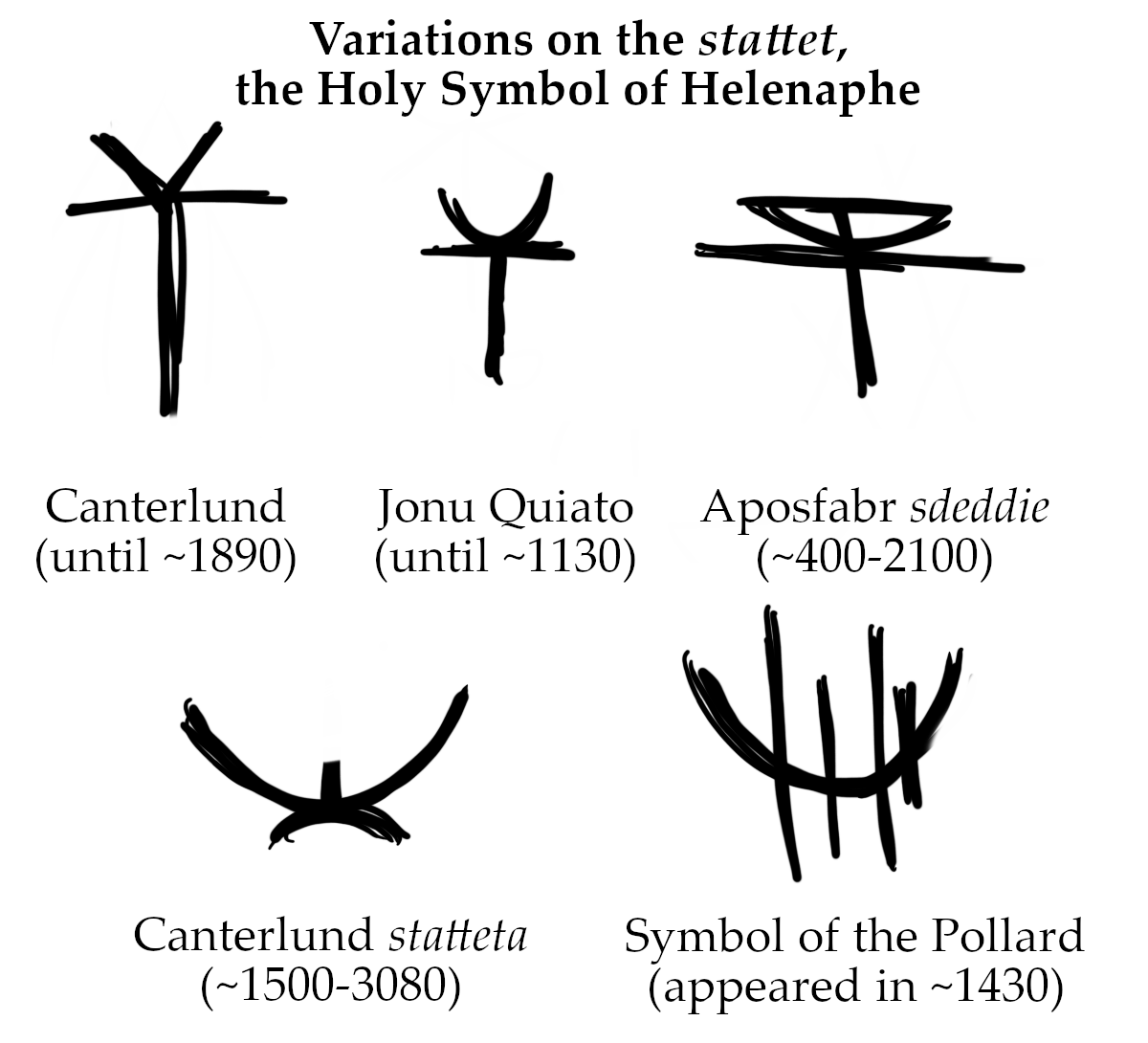Helenaphe
The Arch-goddess, Mother Nature
Imagine a child, a little brown-eyed boy, drowning beneath a cold river. Now picture the child's mother watching from shore, restraining every muscle in her body to keep from leaping after him because she knows already he is lost. That feeling of imminent loss, of restrained salvation. That is Helenaphe.Helenaphe was the most powerful of the known gods and, for all intensive purposes, their supreme leader. She led the Frontier Gods, a group which numbered in the hundreds, out of their disjointed, dying planes and into New Haven with the promise of a better life. But to prepare New Haven for their arrival--that is, by straightening the very flow of time--she exhausted her strength and perished before she could admire her efforts. Yet gods do not die quietly. From her corpse sprung the jungles of the Trinzejar which spreads across modern-day Sulghury. Her religion of Helenaphism resounded throughout the land in many cults and doctrines and was a political influence for millennia. After her death, her daughter, Anaphrene, took up her mantle among the gods. Not keen on being worshipped openly, Anaphrene stuck to the shadows, jotting down the events of the world in her ledger and pulling strings as she saw fit.-- The theologian Ourder Labyson
An Arch-goddess
The gulf in power between a god and a an arch-god is immense. It is hard to say whether an arch-god is a separate being entirely from their lesser kin. Yet Helenaphe herself bore children who grew to possess only a fraction of her abilities which would suggest the difference is something more subtle than genetics. The arch-gods were capable of feats that could force natural laws and birth or eradicate entire species. But their powers were not limitless and such great feats were reserved only for the most dire of situations. Three other arch-gods besides Helenaphe are known and only two of those (Knimehaud and Couter) are widely recognized by theologians and priests alike.The Natural Order
The gods are ageless and near invulnerable to harm yet they can only reside on a handful of worlds. This Divine Deficiency, as theologians ascribe it, is not well understood and likely it is knowledge the gods will never willingly reveal themselves. It is known that time in New Haven before Helenaphe's arrival moved more "freely," with distant moments connected as if in a web. Theologians presume this would have caused the gods great harm or strife which was why Helenaphe made such an effort to correct it. Helenaphe "straightened" the tangle of time on New Haven at the cost of her own life. She did this willingly, knowing her daughters would be there to continue her legacy as supreme arch-goddess and carry out her glorious plans for this world. These "plans" had been little more than [spurious remarks] which Anaphrene diligently noted down and organized. Like an architect to the respected artist, Anaphrene turned her mother's visions into the series of goals and laws known as the Natural Order. The foremost tenant was of course the linearity of time. Other tenants of the Natural Order recognized the gods as supreme and in control of the natural cycles of the earth. Wind and weather, the shifting of rock and magma, the growth and death of plants and animals, the operation of the sun and the moon; these natural cycles, self-regulated by the earth itself for millennia, now fell under the jurisdiction of the gods. Most important to Helenaphe's Order was the creation of humans for worship. Without prayer, the strength of the gods slowly waned and it had been a long time since they left their subjects in those old planes. Anaphrene carried out her mother's instructions for the creation of humans which she lovingly called "Newborns." In her ledger she recording the progress toward her mother's goals and her casual observations of the world. These seminal notes became the basis for the first Natural Bible.Helenaphe the Ruddy
Helenaphe was described in many ways from beautifully kind to recklessly proud. Though perhaps most telling of her appearance and demeanor is the adjective "ruddy" which is attached to her name in at least a hundred places in the Natural Bibles. Her face always flush with life, passion, and fury and many sources attest to her showing both great capriciousness and restraint. She was not one for subtlety or intrigue, preferring to assault her problems rather than work through them. Depictions of Helenaphe are ubiquitous throughout the continent as a tawny-skinned, freckled woman of long, curling, red hair dressed in dirt-stained clothes. She went be many colloquial names including Helenafee, Helenaf, Helen, Helphrene, and Helpher Her symbol, the stattet, emphasizes balance, order, nature, and power and has been interpreted in a thousand different ways by the people of New Haven.
Divine Classification
God
Religions
Church/Cult
Children
Remove these ads. Join the Worldbuilders Guild




Comments